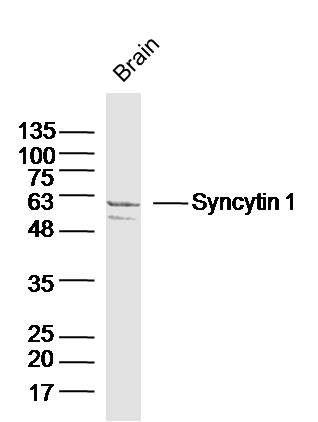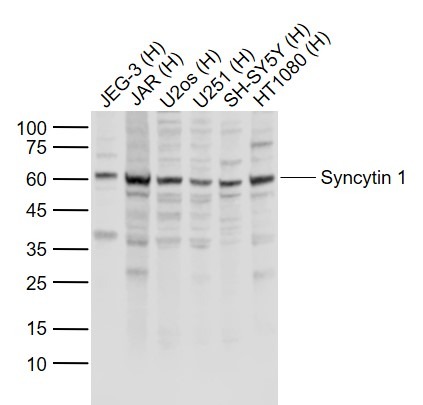购物车
全部删除  您的购物车当前为空
您的购物车当前为空
别名 Syncytin-1, Syncytin, HERV-W_7q21.2 provirus ancestral Env polyprotein, HERV-W envelope protein, HERV-7q Envelope protein, ERVWE1, ERVW-1, Env-W, Enverin, Envelope polyprotein gPr73, Endogenous retrovirus group W member 1
Anti-Syncytin-1 Polyclonal Antibody 是一种 Rabbit 抗体,靶向 Syncytin-1。Anti-Syncytin-1 Polyclonal Antibody 可用于 WB。
Anti-Syncytin-1 Polyclonal Antibody 是一种 Rabbit 抗体,靶向 Syncytin-1。Anti-Syncytin-1 Polyclonal Antibody 可用于 WB。
| 规格 | 价格 | 库存 | 数量 |
|---|---|---|---|
| 50 μL | ¥ 1,160 | 5日内发货 | |
| 100 μL | ¥ 1,975 | 5日内发货 | |
| 200 μL | ¥ 2,785 | 5日内发货 |
| 产品描述 | Anti-Syncytin-1 Polyclonal Antibody is a Rabbit antibody targeting Syncytin-1. Anti-Syncytin-1 Polyclonal Antibody can be used in WB. |
| 别名 | Syncytin-1, Syncytin, HERV-W_7q21.2 provirus ancestral Env polyprotein, HERV-W envelope protein, HERV-7q Envelope protein, ERVWE1, ERVW-1, Env-W, Enverin, Envelope polyprotein gPr73, Endogenous retrovirus group W member 1 |
| Ig Type | IgG |
| 反应种属 | Human,Mouse |
| 验证活性 | 1. Sample: Brain (Mouse) Lysate at 40 μg Primary: Anti-Syncytin 1 (TMAB-01803) at 1/300 dilution Secondary: IRDye800CW Goat Anti-Rabbit IgG at 1/20000 dilution Predicted band size: 33/58 kDa Observed band size: 58 kDa 2. Sample: Lane 1: JEG-3 (Human) Cell Lysate at 30 μg Lane 2: JAR (Human) Cell Lysate at 30 μg Lane 3: U2os (Human) Cell Lysate at 30 μg Lane 4: U251 (Human) Cell Lysate at 30 μg Lane 5: SH-SY5Y (Human) Cell Lysate at 30 μg Lane 6: HT1080 (Human) Cell Lysate at 30 μg Primary: Anti-Syncytin 1 (TMAB-01803) at 1/1000 dilution Secondary: IRDye800CW Goat Anti-Rabbit IgG at 1/20000 dilution Predicted band size: 58 kDa Observed band size: 60 kDa   |
| 应用 | WB |
| 推荐剂量 | WB: 1:500-2000 |
| 抗体种类 | Polyclonal |
| 宿主来源 | Rabbit |
| 亚细胞定位 | Cell membrane |
| 组织特异性 | Expressed at higher level in placental syncytiotrophoblast. Expressed at intermediate level in testis. Seems also to be found at low level in adrenal tissue, bone marrow, breast, colon, kidney, ovary, prostate, skin, spleen, thymus, thyroid, brain and tra |
| 构建方式 | Polyclonal Antibody |
| 纯化方式 | Protein A purified |
| 性状 | Liquid |
| 缓冲液 | 0.01M TBS (pH7.4) with 1% BSA, 0.02% Proclin300 and 50% Glycerol. |
| 浓度 | 1 mg/mL |
| 研究背景 | Many different human endogenous retrovirus (HERV) families are expressed in normal placental tissue at high levels, suggesting that HERVs are functionally important in reproduction. This gene is part of an HERV provirus on chromosome 7 that has inactivating mutations in the gag and pol genes. This gene is the envelope glycoprotein gene which appears to have been selectively preserved. The gene's protein product is expressed in the placental syncytiotrophoblast and is involved in fusion of the cytotrophoblast cells to form the syncytial layer of the placenta. The protein has the characteristics of a typical retroviral envelope protein, including a furin cleavage site that separates the surface (SU) and transmembrane (TM) proteins which form a heterodimer. Alternatively spliced transcript variants encoding the same protein have been found for this gene. [provided by RefSeq, Mar 2010] |
| 免疫原 | KLH conjugated synthetic peptide: human Syncytin 1 |
| 抗原种属 | Human |
| 基因名称 | ERVW-1 |
| 基因ID | |
| 蛋白名称 | Endogenous retrovirus group W member 1 |
| Uniprot ID | |
| 功能 | This endogenous retroviral envelope protein has retained its original fusogenic properties and participates in trophoblast fusion and the formation of a syncytium during placenta morphogenesis. May induce fusion through binding of SLC1A4 and SLC1A5 (PubMed:10708449, PubMed:12050356, PubMed:23492904).3 PublicationsEndogenous envelope proteins may have kept, lost or modified their original function during evolution. Retroviral envelope proteins mediate receptor recognition and membrane fusion during early infection. The surface protein (SU) mediates receptor recognition, while the transmembrane protein (TM) acts as a class I viral fusion protein. The protein may have at least 3 conformational states: pre-fusion native state, pre-hairpin intermediate state, and post-fusion hairpin state. During viral and target cell membrane fusion, the coiled coil regions (heptad repeats) assume a trimer-of-hairpins structure, positioning the fusion peptide in close proximity to the C-terminal region of the ectodomain. The formation of this structure appears to drive apposition and subsequent fusion of membranes. |
| 分子量 | Theoretical: 59 kDa. |
| 储存方式 | Store at -20°C or -80°C for 12 months. Avoid repeated freeze-thaw cycles. |
| 运输方式 | Shipping with blue ice. |
| 存储 | store at low temperature | store at -20°C |